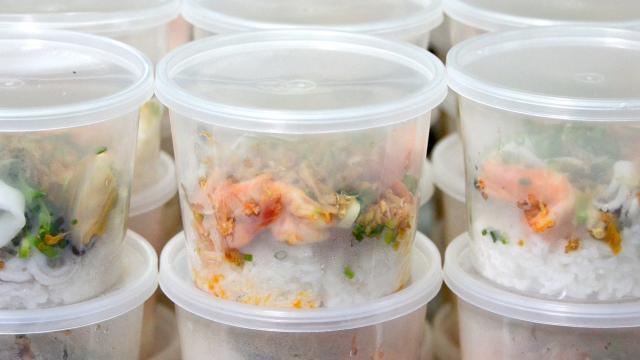Even though my apartment rarely contains more than two people at a time, I cook as if I’m feeding a family of four. This is mostly due to my line of work, but it’s exacerbated by my tendency to overestimate how much food I can eat at any given meal. Food storage is therefore critical, and while I have tried a wide variety of food-storage systems, none come close to the ease and efficacy of using soup containers (not deli containers, which are similarly shaped but flimsy — soup containers will look slightly more opaque).
Ever since I bought two sleeves of soup containers (in two different sizes) at the restaurant supply store, I have used little else. I will occasionally bust out a repurposed jam jar (for salad dressings, small amounts of sauce, and emergency cocktails), and I’ve been know to use a freezer bag here and there, but I would estimate 90% of my food — leftovers, homemade condiments, pickles, and dry goods — gets stored in a plastic soup container. And I’m not the only one. A.A. Newton (who turned me on to them in the first place) has sung their praises before:
The buckets come in several sizes, but the lids are universal. You can put them through the microwave, dishwasher, and freezer. Empty or full, they stack efficiently. Their flexible material makes them super easy to pour from: just squeeze the sides gently to make a spout. They’re recyclable, but they’re so cheap ($7-15 for a sleeve of 50 depending on where you get them) that tossing a months-old bucket of rotted mystery fluid straight into the garbage isn’t the end of the world.
I simply cannot stress how much the stacking factor matters to me. As I mentioned earlier, my fridge (and entire kitchen, really) are small, and containers that stay stably stacked on top of one another make my life much, much easier. Like A.A. Newton before me, I take advantage of their wide-mouth openings to make mayo and other emulsified dressings right in the container, and their ability to withstand a broad range of temperatures means I can fill them with vegetables and pour boiling pickle brine right on top, then turn around and pop them in the fridge or freezer.
All that, and they’re transparent, which means I can actually see the food stored inside, making it exponentially more likely I will eat it before it goes bad. (What do I do if I need to store something that is larger than a soup container, like a roasted chicken? I simply leave it in its roasting pan and cover it with plastic wrap — but any pan juices go into a soup container.)
Yes, they are plastic, but they are plastic that is designed to hold food — even very hot food — and they’re cheap enough that you can toss them into the recycling the moment you feel they’re wearing out. They’re pretty durable and, unless you’re putting them in the microwave on a daily basis, I’ve found they last a very long time (pretty much indefinitely if you only use them for cold and room temperature storage).
Finally, they are light and virtually unbreakable. Though I love the look of glass containers, the good ones are heavy and — no matter how thick and tempered the glass is — they can shatter if dropped. The weight of a Pyrex dish may not be that big of a deal to some of you, but the heaviness of kitchen equipment is something I’ve been thinking about more and more recently, especially now that my mother is developing arthritis in her wrists and hands from decades of as a veterinarian (neutering thousands of animals really wears on those joints, as it turns out).
Plus, if you have kids, lightweight containers are a little easier for them to grab and hold than heavy containers made of glass that they could drop, break, and potentially cut themselves with. I don’t have any children, but I imagine they are always dropping things.
What are your favourite ways to store food? Our health and science editor, Beth Skwarecki, loves the square, black, tray-like takeout containers, especially for meal planning (which I do not really engage in). Make a case for your container of choice in the comments below.

Leave a Reply
You must be logged in to post a comment.